
The St. Lawrence and Atlantic Railroad, known as St-Laurent et Atlantique Quebec in Canada, is a short-line railway operating between Portland, Maine, on the Atlantic Ocean, and Montreal, Quebec, on the St. Lawrence River. It crosses the Canada–US border at Norton, Vermont, and Stanhope, Quebec, and is owned by short-line operator Genesee & Wyoming.

The railroad history of Portland, Maine, began in 1842 with the arrival of the Portland, Saco & Portsmouth Railroad (PS&P). Most of the rail activity in Portland concerned agricultural goods bound for export and European import freight. But Maine's largest city also enjoyed 125 years of continuous passenger rail service from 1842 until 1967, and has been served by Amtrak since 2001. For most of Portland's history, passenger train schedules were designed with intercity travel—to Boston, Montreal, Nova Scotia, and points west—rather than daily commuting.
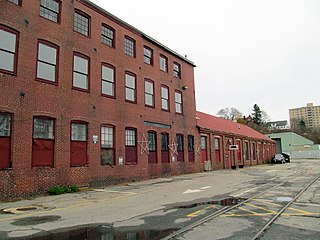
The Portland Company was established 10 November 1846 by John A. Poor and Norris Locomotive Works engineer Septimus Norris as a locomotive foundry to build railroad equipment for the adjacent Portland terminus of the Atlantic and St. Lawrence Railroad connection between Portland, Maine, and Montreal. The shops opened for business in October, 1847. Its first locomotive, the Augusta, emerged from the shops in July 1848 for delivery to the Portland, Saco & Portsmouth. Over the next several decades, the Company produced in its Fore Street facilities over 600 steam locomotives as well as 160 merchant and naval vessels, railcars, construction equipment, Knox automobiles, and the like. Portland Company built the engines of the civil war side-wheel gunboats Agawam and Pontoosuc. Taking into account its other products, the Company could lay claim to being one of the leading medium-to-heavy steel manufacturers in New England. The company ceased production in 1978.
Grand Trunk railway stations or Grand Trunk railroad stations may refer to former and active passenger rail stations built for the Grand Trunk Railway or its subsidiaries the Grand Trunk Western Railroad and the Grand Trunk Pacific Railway.
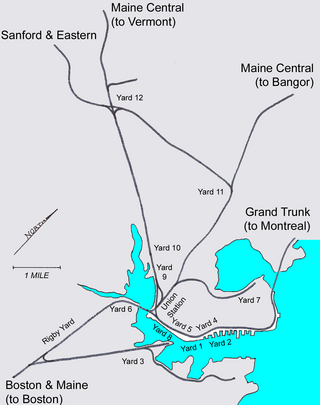
The Portland Terminal Company was a terminal railroad notable for its control of switching (shunting) activity for the Maine Central Railroad (MEC) and Boston & Maine (B&M) railroads in the Maine cities of Portland, South Portland, and Westbrook.

The Grand Trunk station is a historic railroad station at 103 Lincoln Street in Lewiston, Maine. It was built in 1874 for a spur line connecting Lewiston and Auburn to the Grand Trunk Railway, to which it was leased. It is through this station that many of the area's French Canadian immigrants arrived to work in the area mills. The station was added to the National Register of Historic Places in 1979.

The History of Portland, Maine, begins when Native Americans originally called the Portland peninsula Məkíhkanək meaning "At the fish hook" in Penobscot and Machigonne in Algonquian. The peninsula and surrounding areas was home to members of the Algonquian-speaking Aucocisco branch of the Eastern Abenaki tribe who were forcibly relocated to current day Canada during European settlement.
The Worcester, Nashua and Rochester Railroad was a railroad line that was to link the city of Worcester, Massachusetts, to the city of Portland, Maine, via the New Hampshire cities of Nashua and Rochester, by merging several small shortline railroads together.
Spier, Rohns & Gehrke was a noted Detroit, Michigan architectural firm operated by Frederick H. Spier and William C. Rohns, best remembered for designs of churches and railroad stations. These were frequently executed in the Richardson Romanesque style. F.H. Spier, W.C. Rohns and Hans Gehrke were authors of the Detroit Chamber of Commerce, tallest building in the city at the time of construction (1895). Hans Gehrke's well known structures include the Fire Department Headquarters on Larned Street in Detroit, and residence of Robert C. Traub in Arden Park residential district of Detroit.
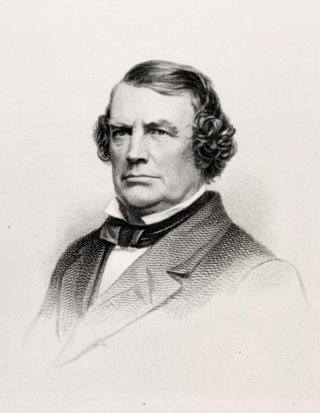
John Alfred Poor was an American lawyer, editor, and entrepreneur best remembered for his association with the Grand Trunk Railway and his role in developing the railroad system in Maine. He was the older brother of Henry Varnum Poor of Standard & Poor's, who was his partner in some business ventures. John Poor was an articulate man standing 6 feet, two inches tall and weighing over 250 pounds (110 kg). He learned the geography and commerce of northern New England during travels as a young man; and developed an early appreciation for the potential of railroads. His commanding presence was enhanced by early speaking experience as a teacher and attorney. He had a unique ability to assemble the necessary resources to build early railroads, although he left the routine work of operations to others.
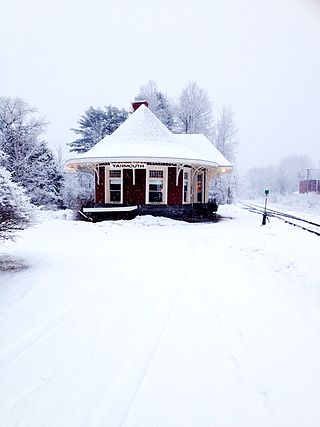
Yarmouth station of Yarmouth, Maine, is located on the east side of the railroad tracks, just south of Maine State Route 115, the town's Main Street. The railroad station was built in 1906 by the Grand Trunk Railroad, and is a well-preserved example of an early 20th-century passenger rail depot, an increasingly rare sight in the state. The building, which is now in commercial use, was added to the National Register of Historic Places on July 10, 1979.
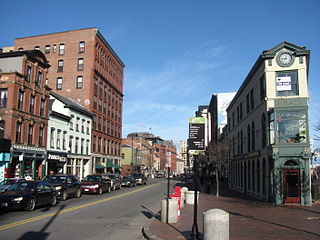
Congress Street is the main street in Portland, Maine. Around 5.77 miles (9.29 km) long, it stretches from County Road, Portland's southwestern border with Westbrook, through a number of neighborhoods, before ending overlooking the Eastern Promenade on Munjoy Hill. In March 2009, the Portland City Council designated much of the inner portion of Congress Street a historic district. The western section of the street includes the city's Arts District.
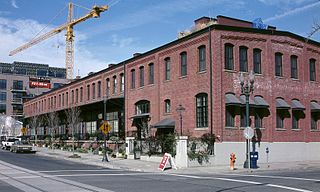
The North Bank Depot Buildings, in central Portland, Oregon, United States, are a pair of buildings formerly used as a freight warehouse and passenger terminal for the Spokane, Portland and Seattle Railway (SP&S). Formed in 1905, the SP&S was commonly known as the North Bank Road during the period in which these buildings were in use. The Portland buildings' passenger facilities were also used by the Oregon Electric Railway after that railway was acquired by the SP&S. Located in what is now known as the Pearl District, the buildings were listed on the National Register of Historic Places in 1996. They were in use by the SP&S and its successor, Burlington Northern Railroad, from 1908 until the 1980s. Only the east building was used as a passenger station, and this usage lasted from 1908 until 1931.

Berlin station is a railroad station in Berlin, New Hampshire, United States. It was built in 1917, long after the arrival of the railroad in 1845, the reason being that Berlin was not on the railroad's main line further south at Gorham, New Hampshire.
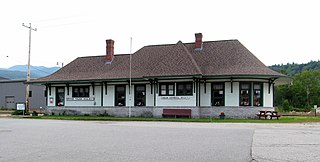
Gorham station is a former Grand Trunk Railway station in Gorham, New Hampshire, United States. It was built in 1907, long after the arrival of the railroad in 1851. The existing station was the third depot. The first was in the White Mountain Station House, which was built by the railroad on what is now the Town Common. When it later became the Alpine House, a small depot was built just east of the hotel. Eventually the Alpine House was moved across Main St. to become the Mt. Madison Inn. Thus a new depot was built in 1907, with a 400' platform.

Forest Avenue is a major street in Portland, Maine, United States. It runs for around 4.78 miles (7.69 km), from Bridgton Road in the northwest to Congress Street, in downtown Portland, in the southeast. It is the main artery for traffic entering and leaving Portland to and from the west via city streets. Forest Avenue passes to the south of Back Cove, while Washington Avenue passes to its north. The street ends in Portland's Arts District.

Union Station was a train station in the Libbytown neighborhood of Portland, Maine, which operated from 1888 to 1960. Located on St. John Street, it was demolished in 1961 and is now the site of a strip mall.
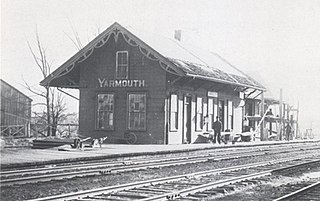
Yarmouth Junction station was a passenger rail station in Yarmouth, Maine, United States. It stood to the west of East Elm Street at Depot Road, at the junction of the former Grand Trunk Railway and the Maine Central Railroad, around 0.9 miles (1.4 km) north of the town's Railroad Square, where today's 1906-built Grand Trunk station stands. The Amtrak Downeaster utilizes the former Maine Central Railroad line, which passes to the northwest of town. The Yarmouth Junction station building is now gone, but the junction itself is still active.

India Street is a downtown street and neighborhood in Portland, Maine, United States. Situated near the western foot of Munjoy Hill, it runs for around 0.28 miles (0.45 km), from Congress Street in the northwest to Commercial Street and Thames Street in the southeast. It was the city's first street, and the location of the first settlement of European immigrants to the city in the 17th century. There are thirty handmade bricks in the sidewalk commemorating the neighborhood's notable events. In 1680, when Thomas Danforth was Deputy Governor of the Massachusetts Bay Colony, the street was known as Broad Street. After the incorporation of the Town of Falmouth in 1718, the street was known as High King Street.

Portland Railroad Company (PRR) was a trolleycar service that was based Portland, Maine, between 1860 and 1941.


















